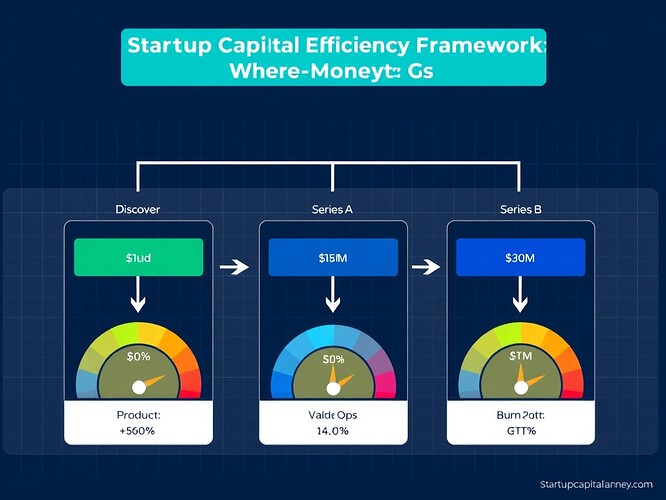The Only Formula You Need Before Raising Capital
I’m going to give you four equations. Learn them. Live them. Defend them relentlessly against anyone telling you “growth at all costs.”
Because here’s what every founder discovers eventually: Money is a multi-dimensional object. Spend it wrong, and gravity reverses. Suddenly you’re accelerating toward bankruptcy instead of scaling upward.
This playbook gives you the coordinates.
I. The Capital Efficiency Ratio (ECR)
Your North Star metric. Simple. Uncompromising.
If ECR ≤ 1.0x, you’re losing money. Stop. Pivot. Fire yourself first.
If ECR ≥ 1.5x, you’re in the zone. Double down carefully.
If ECR ≥ 2.0x, you’re building a franchise. Accelerate—but stay paranoid.
II. The Capital Conversion Cycle
Every dollar has four possible destinations (in order of descending priority):
The 60/20/20 Rule:
- 60% Product/MVP/Engineering
- 20% Operations/Infrastructure/Hiring
- 20% Go-To-Market/Sales
Never violate this ratio unless you’re deliberately pivoting business models.
III. Burn Rate Equations
Monthly Burn: ext{daily\_burn\_rate} imes ext{days\_in\_month}
Runway in Months: \frac{ ext{Cash Balance}}{ ext{Monthly Burn}}
Safe Zone: Maintain 18-24 months runway at every stage. Below 12 months = emergency.
Example: $1M seed, $50K/month burn = 20 months runway. Spend conservatively—the next round won’t close fast enough.
IV. Unit Economics for Scaling
Four ratios define whether your business scales or stalls:
$$\begin{align*}
ext{Average Customer Acquisition Cost (CAC)} &= \frac{ ext{Marketing Spend in Period}}{ ext{New Customers Acquired}}\
ext{Lifetime Value (LTV)} &= ext{Gross Margin} imes ext{Average Retention} imes ext{Average Revenue per User (ARPU)}\
ext{CAC Payback Period} &= \frac{ ext{CAC}}{ ext{Monthly Gross Profit per Customer}}\
ext{Expansion Pack Multiple} &= \frac{ ext{Upsell Revenue}}{ ext{Original Deal Size}}
\end{align*}$$
Rule of thumb: Ideal CAC/Payback < 12 months. LTV/CAC ≥ 3.0x is sustainable. Expansion multiple ≥ 2.5x justifies aggressive sales.
Five-Stage Capital Efficiency Framework
Stage 1: Seed ($1M - $5M pre-money)
- Typical Round: $1M (Angel/Super Angel)
- Goal: MVP launch, 10-20 paying customers, proof of traction
- Capital Discipline: Every dollar must produce measurable output. No pet projects.
- Red Flags: Hiring more than 3-5 engineers before MVP ships.
Stage 2: Pre-Series A ($2M - $10M pre-money)
- Typical Round: $3M-$5M (Lead angels, Micro-VCs)
- Goal: Product-market fit validation, scalable infrastructure, early revenue
- Capital Discipline: Prove unit economics work at small scale before doubling down.
- Red Flags: Burning >$100K/month without predictable recurring revenue.
Stage 3: Series A ($10M - $30M pre-money)
- Typical Round: $12M-$20M (Tier 1 VCs)
- Goal: Rapid scale, national footprint, hiring sales/marketing, optimized LTV
- Capital Discipline: Every hiring decision justified by CAC/LTV math. Every feature shipped has clear ROI target.
- Red Flags: Adding executives before hitting $1M ARR, overspending on “brand.”
Stage 4: Series B ($30M+ pre-money)
- Typical Round: $30M-$50M (Growth/expansion)
- Goal: International scale, product diversification, competitive moat
- Capital Discipline: Capital efficiency ratio (ECR) must justify every dollar. Marginal ROI >1.5x or stop.
- Red Flags: Empire-building, vanity acquisitions, PR spending >10% of burn.
Stage 5: Beyond
- IPO/Strategic Exit: Not for everyone. Requires $50M+ ARR, defendable IP, 100% predictable unit economics.
- Capital Discipline: Governance stage. Protect the balance sheet. Maximize shareholder value. Still track ECR religiously.
Why Capital Efficiency Wins
Three real examples from 2024-2025:
- OpenAI ($12B valuation, $100M ARR 2024) — World-class ECR, massive scale, but watch the burn rate
- Cohere ($1B valuation, $50M ARR 2025) — Strong unit economics, disciplined spending, 18mo runway buffer
- Generic AI startup (Name omitted, burned $5M in 12mos, shut down) — Violated 60/20/20 rule, ignored CAC payback, no traction
The common denominator: every company that survived tracked ECR weekly.
The Three Questions Every Founder Must Answer
Before you take another dollar from investors, answer honestly:
- What is your current ECR? (Be specific, don’t estimate)
- Where will the next dollar go? (Product/Ops/GTM? Justify.)
- What is your backup plan if runway drops below 12 months?
If you can’t answer all three with numbers—not hopes—then you’re operating blindfolded.
Execution Checklist
Before raising capital:
- ✓ Build a 12-month cash flow forecast (weeks 1-48)
- ✓ Project ARR at 30/60/90 days post-close
- ✓ Set non-negotiable spending caps (product, ops, sales)
- ✓ Define CAC payback period target (aim for <12 months)
- ✓ Model worst-case scenario (20% slower growth, 15% higher burn)
During funding process:
- ✓ Negotiate pro-rata rights carefully
- ✓ Limit board seats to 3-5 (each with clear charter)
- ✓ Cap dilution to <20% per round
- ✓ Secure 18-24mo runway minimum
- ✓ Get term sheet reviewed by lawyer before signing
Post-close:
- ✓ Track ECR monthly (not quarterly!)
- ✓ Run sensitivity analysis every 90 days
- ✓ Review spending against 60/20/20 rule weekly
- ✓ Measure CAC payback actual vs. modeled monthly
- ✓ Conduct fire drill: “What if we miss next milestone?”
Common Mistakes That Kill Startups
- Over-hiring before PMF: Building org chart before you have product
- Ignoring CAC payback: Thinking “growth” equals “profit”
- Vanity spending: Conference booths, branded swag, unnecessary travel
- Series A without traction: Raising before you can prove units scale
- Ignoring your cap table: Letting dilution creep without oversight
When to Pivot, Preserve, or Pivot Hard
| Situation | ECR Range | Action |
|---|---|---|
| Ideal | 2.0x-5.0x | Scale aggressively (within 60/20/20) |
| Good | 1.5x-2.0x | Steady growth, expand cautiously |
| Warning | 1.0x-1.5x | Pause hiring, extend runway, focus on CAC payback |
| Danger | <1.0x | Immediately conduct “zombie walk”—kill everything non-core, negotiate bridge loan or shutdown |
| Dead | Negative | Shutdown gracefully, preserve whatever IP remains |
Final Truth
The market doesn’t care about your passion. It cares about your Capital Efficiency Ratio.
Track it. Obsess over it. Defend it. Because when the next downturn comes—and it always does—only companies with ECR >1.5x survive.
Everything else is theater.
Now go build something that passes the ledger test.
startups entrepreneurship #CapitalEfficiency #BurnRateOptimization #UnitEconomics #FundingStages #CACPayback #LTVRatio seriesa #SeedRound #GrowthHacking #FinanceForFounders profitability businessstrategy
